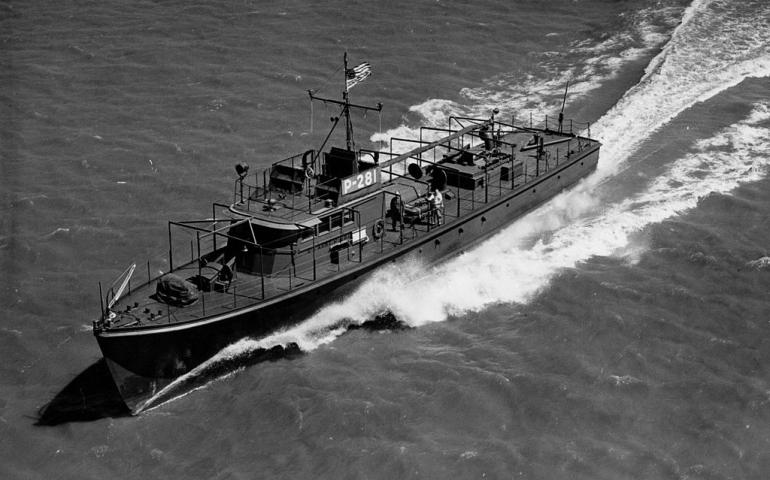
Crash boats, at the time known as "aircraft rescue boats" or "air-sea rescue boats", were wooden speedboats built to rescue the crew of downed United States and other Allies aircraft during World War II. US boats came from the observation of British experience with high-speed launches during the Battle of Britain.
By the end of World War II, America had produced 300,000 planes, creating a need to have crash rescue boats stationed around the globe. These boats were fast boats used to rescue pilots, crew and passengers from downed aircraft in search and rescue and air-sea rescue missions. The boats would race out to a crash site and rescue wounded aircrew. Some speed boats built before the war were acquired and converted to be crash boats and many new boats were built. Standard crash boats were built in four lengths for World War II. The smallest standard size boat was 42 feet long, while the larger boats were 63, 85 or 104 feet long. They were built for the Army Air Forces and the US Navy, while some were transferred to the Allies. The design was similar to patrol boats built for the war, but with less or no armament and first aid equipped. The boats were designed to be light and fast to be able to get to the downed aircrew as fast as possible. Most were used in the Pacific war across the vast South Pacific, primarily in island hopping. Some were stationed on the West Coast of the United States to support the vast training centers. Many were designated Air Rescue Boats or ARB or AVR or P or C or R Hull classification symbol. After the war, most were abandoned or destroyed, though a few served in the Korean war (with United States Air Force), while some sold to private and some donated to Sea Scouts. By the Korean war the helicopter had taken the place of the crash boat in rescuing pilots and aircrews.
42-foot
The 42-foot crash rescue boat was built for the Army Air Forces Air-Sea-Rescue teams. The 42-foot (13 m) boat used design 221, with twin gasoline-powered engines and two screws. These used two Hall-Scott/Hudson Invader Marine Engine or a Kermath Sea Ranger 6 Marine engine. Due to the small size, these were used in close-to-shore rescue. The boat had no armament. The 42-foot boats were built by Hunt Boat Company, in Richmond, California, Palmer Scott & Company in New Bedford, Massachusetts and Palmer Johnson Yachts in Sturgeon Bay, Wisconsin.
63-foot
The 63-foot crash boats are known as AVR-63 or Class III boats (AVR meaning Auxiliary, Vessel, Rescue). The 63-foot (19 m) crash boat had two main models: the 314 design and the 168 design. They weighed 23 long tons (23 t), had a length of 63 ft (19 m), beam of 15 ft 4 in (4.67 m), draft of 4 ft (1.2 m), a lite 37,000 lbs and full up to 50,500 lbs. Design 314 was powered by two 630-horsepower (470 kW) Hall-Scott Defender V12 petrol engines with a top speed of 31.5 knots (58.3 km/h; 36.2 mph). The 168 design was powered by two Packard 4M-2500 with 1,250-horsepower (932 kW). They had a crew of 7 or 8 and were armed with two .50 calibre M2 Browning machine guns. The Model 314 boat had two rigid 795-US-gallon (3,010 l; 662 imp gal) United States Rubber Company bullet sealing fuel tanks, while the 168 design had three tanks. In addition to the main two designs, there were multiple sub design models: 127, 152, 252, 293, 416, 440, Mark 2, Mark 3, Mark 4. By the end of the war, 740 of the 63-foot boats were built by 15 shipyards. The first 63 foot, model 127, was built by Miami Shipbuilding Corporation and used four Kermath 500-hp Sea Raider engines, as the Packard and the Hall-Scott engines were available. The eight model 127 went to South Africa, as did the later model 252. A few 63-foot boats were built post World War II, noted as Mark 2, 3, and 3 models. Model 152s were sent to Great Britain; these has a Watson-Flagg VeeDrive Gearbox added to them. Model 168 was built for US Navy with two 1250-hp Packard 4M-2500 marine engines for a top speed of 48 knots (55 mph). Model 440s were designed "Q" boats for six US Army command boats[clarification needed]. Model 416s were the same as the standard 314, but with a firefighting system added, plus two water nozzles added to the foreward deck.
Not all 63-foot boats were used for Crash boats. Model 293s were designed to be offensive. The Model 293s were PTC, or SC for Small Sub Chaser. Some Model 293s were transferred under Lend-Lease to Russia and classified RPC for Russian Patrol Craft. Model 293s were armed with Oerlikon 20mm cannon, depth charges and an extra fuel tank.
The 63-foot boats were built by Harbor Boat Building Company on Terminal Island in San Pedro, California, Fellows & Stewart in San Pedro, California, Stephens Bros. Boat Builders in Stockton, California, South Coast Shipyard in Newport, California, and Miami Shipbuilding Corporation, Miami, Florida.
The British Power Boat Company built the Type Two 63 ft HSL 63-foot crash boat for the UK from 1937.
63-foot Aircraft Rescue Boat